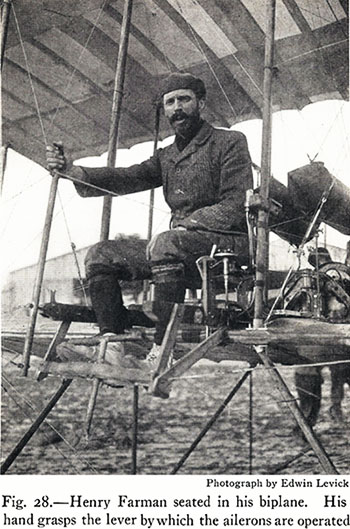Aeroplanes in Embryo
Today, aeroplanes in embryo. The University of Houston's College of Engineering presents this series about the machines that make our civilization run, and the people whose ingenuity created them.
The first countries to build successful heavier-than-air flying machines were the US and France. Our Wright Brothers flew in 1903. They were soon followed by California's John Montgomery, Alexander Graham Bell and others. From among them, Glenn Curtiss emerged from the pack to become our one early airplane maker who proved to have real staying power.

From Kaempffert's 1911 book on aeroplanes: Glenn Curtiss' 1908 June Bug
France was equally quick to get in the game. Brazilian-born French designer Santos-Dumont was making tentative flights and rapid improvements in a pretty primitive aeroplane by 1906. A year later he had a real success with an aeroplane he called Demoiselle.

But three other French airmen went on make France a true mother of flight. They were Louis Bleriot, Henry Farman and Gabriel Voisin. Bleriot and Voisin worked together; then each went his own way. Bleriot went on to first fly the English Channel.
Farman entered the picture in 1907 when he hired Voisin to build him an aeroplane. They called it the Voisin-Farman I. And it was the first flying machine to stay aloft more than one minute. It was first to navigate a circular course.

Click on the image above for plans from which you can build this Farman-Voisin I biplane.
Like the Silicon Valley pioneers of the 1950s, these early French designers joined and divided like amoebas. When Voisin stayed with his workable but still primitive airframe, Farman left to build his own planes. He lost the race to first fly the English Channel, to Bleriot. But, he'd already set a distance record over land that was three times the Channel's width.
If, a century ago, you'd asked the names of famous fliers, Farman's might've headed the list. He was everywhere -- at meets, making exhibition flights, even teaching one of the first women to fly. Sculptor Thérèse Peltier learned in a Farman-Voisin.
 Farman went on to make ever better planes. He made some of the first reconnaissance planes in WW-I. Toward the war's end, he began building his F-60 Goliath bomber; then quickly recast it for civilian use. It was a large two-engine, 12-person biplane with a 250-mile range. It carried passengers all through the 1920s.
Farman went on to make ever better planes. He made some of the first reconnaissance planes in WW-I. Toward the war's end, he began building his F-60 Goliath bomber; then quickly recast it for civilian use. It was a large two-engine, 12-person biplane with a 250-mile range. It carried passengers all through the 1920s.
Farman hit his stride in civilian aircraft. The year I was born, he built a fine eight-passenger tri-motor, much like the Fokker and Ford Trimotors of that time. He emerged from this gaggle of the earliest pioneers as someone who could reach across time into a new era of safe passenger service. Farman Airlines offered
routes with exotic names like Etoile d'Argent (or Gold Star), Air Orient, and TransAfrican Aviation Company.
So aeroplanes were born of two parents at the beginning of the 20th century -- America and France. And, in each country, one person seemed to emerge as the founding pioneer who could reach into the new airplane-served world of the 20th century. Glenn Curtiss' name still graces the Curtiss-Wright Company. But France's equally remarkable Henry Farman has largely faded into memory's mists.
I'm John Lienhard at the University of Houston, where we're interested in the way inventive minds work.
Above, I have linked to Wikipedia and Engines articles on Curtiss, Farman, Santos-Dumont, Voisin, Peltier, Bleriot, Montgomery, Bell, and some of the aeroplanes I mention in the article.
Excellent sets of images of aeroplanes from this era may be found in the following sources: J. Stoff, Picture History of Early Aviation, 1903-1913. (New York: Dover Publications, 1996); W. Kaempffert, The New Art of Flying. (New York: Dodd, Mead and Co., 1911); and V. Lougheed, Vehicles of the Air: A Popular Exposition of Modern Aeronautics with Working Drawings. (Chicago: The Reilly and Britton Co. 1909/1910). All period photos are from the latter two sources. Color photos by J. Lienhard
Henry Farman was born in France, but the son of an English correspondent living in Paris. The French called him Henri, but his given name was Henry.

Farman-Voisin aeroplane at the old Rhinebeck Aerodrome. Photo by J. Lienhard